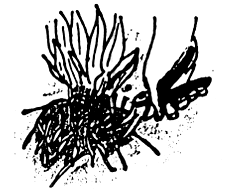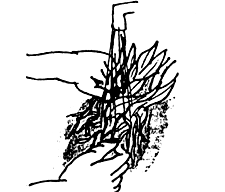Hydroponics How-To
Before you Begin ...
-
Start slow! Don't re-pot your entire collection at once.
-
Begin with a healthy plant. Learn how Hydroponics works with healthy,vigorous plants before attempting to use this system for rejuvenating sick or weak ones.
-
Best time for transplanting is after bloom cycle.
-
Use a Culture pot the same size or slightly smaller than existing pot. Hydroponics does not require large growing containers.
-
Soak Pellets in a water/rooting hormone mixture overnight. One tablespoon of K-L-N per gallon of water is recommended. This same mixture will be used for watering later. A K-L-N solution will keep up to 6 months
|
1. Remove orchid from its pot by tapping side of pot to loosen roots. Carefully tease apart roots, removing as much planting material as possible.
|

|

|
2. Take a close look at the root system. Trim away any discolored or unhealthy roots. Be careful not to damage healthy roots. Don't worry if you have only a couple of roots left. New roots will grow back.
|
|
3. Wash roots thoroughly, removing ALL planting material.
|

|

|
4. Cover the whole bottom of the Culture pot with Pellets. Hold the plant in position in the pot and add more Pellets until the plant is securely held in place.
|
5. Tap Pellets down for stability. Correct planting depth is important. Plants should be positioned deeper into Hydroponic pots than in traditional pots. If plant is too high, dump out Pellets and start over. Place Culture pot into it's outer, decorative, container.
Don't add water yet - the Pellets will already be saturated.
|

|
Now What...

|
- During the first 3-4 weeks water plant by misting the leaves daily and wetting the Pellets when dry.
- Don't allow standing water at the base yet. Use K-L-N rooting
hormone
to promote root growth - one tablespoon per gallon of water.
- In about a month, start using Hydroponic Growing nutrients at 1/2 strength. Water plants only until the water gauge moves - then stop! (The "max", "opt" and "min" markings on the indicators are used for regular house plants, not for orchids.)
- Give plant plenty of time to use up all the water before adding more. Remove Culture pot from outer container to make sure system is completely dry before re-watering.
|
|
Note: Clay Pellets hold more water than you would think. Try this for starters - Set a pot kit (without a plant) next to the new transplant. Water both pots equally. To check if watering is necessary, simply dump out the Pellets from the empty pot.If the Pellets from the empty pot are at all still wet, or if there is any water remaining in the container, then watering the potted plant is not Currently needed.
Remembering the Basics:
Caring for orchids is not difficult, just different. In nature most houseplants grow on the forest floor. Orchids, on the other hand, like growing in trees and on rocks! That's why they need different care.
|
Light:
|
Orchids need bright light, about 14 hours a day.
|
|
Humidity & Temperature:
|
Orchids need a minimum of 50% humidity. Use Temperature humidity trays or group plants to create more humidity. Know what temperatures your orchids require. Cooler temperatures tend to prolong blooms.
|
|
Water:
|
Orchids don't like wet feet! Always check bottom of Culture pot for dryness before re-watering. Apply nutrients carefully. More problems occur from too much fertilizer than not enough.
|